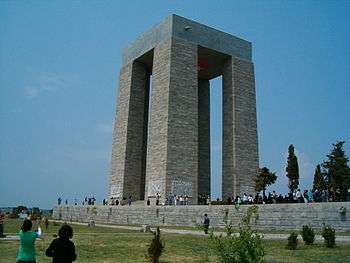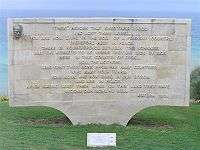Gallipoli
Gallipoli (Turkish: Gelibolu) is a peninsula locality in north-western Turkey, close to Istanbul. The Gallipoli Peninsula is the site of extensive First World War battlefields and memorials on the north bank of the Dardanelles Strait. It is a commemorative site for the Allied (British Empire, France) and Turkish forces who fought, died and were wounded there. The Gallipoli Campaign also known as the Battle of the Dardanelles was very costly for both sides, and casualties and losses amount to 220,000 with a 59% casualty rate for the Allied forces, and 253,000 with a 60% casualty rate for the Turkish forces.
- For other places with the same name, see Gallipoli (disambiguation).

The battle resonated profoundly among some nations involved. In Turkey, the battle is perceived as a defining moment in the history of the Turkish people—a final surge in the defence of the motherland as the centuries-old Ottoman Empire was crumbling; and in Australia and New Zealand, the then perceived duty to serve their "Mother Country" Britain, resulted in their military defeat, but their sacrifice and heroism marked the birth of a separate national consciousness in both of these countries.
The Gallipoli peninsula is one of the most sacred sites for the Turkish nation, with many monuments such as the Monument of Martyrs erected in the honor of the Turkish soldiers who died in the Battle of the Dardanelles against the Allied forces, whose defeat staved off a potential invasion of Turkey. The victory over the Allies is celebrated on 18 March as Çanakkale Zaferi (Çanakkale Victory), every year, with tens of thousands of Turks attending the events on the battlefields and memorials.
The area around Anzac Cove is particularly significant for Australians and New Zealanders, whose armies received their baptism in fire on the cliffs there, and carved a fine military reputation under extreme adversity and enormous loss of life; and this military disaster marked the beginning of a separate Australian and New Zealand nationhood. The 1915 landings and battles are commemorated by Australians and New Zealanders on ANZAC Day, 25 April, every year. At this time especially, Gallipoli becomes a place of pilgrimage for many Aussies and Kiwis who want to honour the memory of their forbears.
Understand
Gallipoli is an elongated (around 40–50 km from its one end to another) peninsula stretching southwest from Thracian mainland, between the Bay of Saros (an indentation of Aegean Sea) and the Straits of Dardanelles. The peninsula is named after a town (Gelibolu) on its northeastern tip, near where it connects to the rest of the mainland. The battles took place in scattered locations around its southwestern end, where the peninsula fronts the Aegean Sea on a coastline full of cliffs.
It was this geographical location—at the entrance of the Dardanelles, and thus on the supply route to Russia via the Sea of Marmara, Bosphorus, and the Black Sea—why the Gallipoli Campaign was planned in the first place.
In addition to the battlesites, there are plenty of pleasant vistas to be enjoyed in the peninsula, including pine forests, views over the sea from hilltops, and beautiful olive groves along the roadsides.
Climate
| Gallipoli | ||||||||||||||||||||||||||||||||||||||||||||||||||||||||||||
|---|---|---|---|---|---|---|---|---|---|---|---|---|---|---|---|---|---|---|---|---|---|---|---|---|---|---|---|---|---|---|---|---|---|---|---|---|---|---|---|---|---|---|---|---|---|---|---|---|---|---|---|---|---|---|---|---|---|---|---|---|
| Climate chart (explanation) | ||||||||||||||||||||||||||||||||||||||||||||||||||||||||||||
| ||||||||||||||||||||||||||||||||||||||||||||||||||||||||||||
| ||||||||||||||||||||||||||||||||||||||||||||||||||||||||||||
Average temperature values in nearby Çanakkale are as in the list to the right.
Get in
By car
The national park which includes the battlefields lies close to the main Istanbul–Çanakkale road, the highway D-550/E87/E90. Driving from Istanbul involves passing through Eastern Thrace (European Turkey) from its eastern end to the southwestern one, mostly closely following the coast of the Sea of Marmara.
Here is a quick description of the route:
- Take either D-100 or O-3/E80 (motorway/toll-road) west, generally signposted as the direction to 'Edirne' in and near Istanbul. Quit the motorway at the Kınalı exit (follow the signs for 'Tekirdağ') to D-100, and at a major interchange you will soon approach, take the direction to Tekirdağ on the highway D-110/E84.
- Within about two hours after your departure from Istanbul, you will arrive in Tekirdağ, the first major city on your route. The highway will direct you to the ring road, which draws an arch around the city. For a meal or a short brake in this lovely city, follow the white Şehir Merkezi sign into the city centre. You can find some decent restaurants and cafes on the waterfront near the harbour.
- Afterwards, the route will bring you to Malkara and Keşan, in about an hour from Tekirdağ.
- At the major junction in Keşan, take the ramp signposted to Gelibolu and Çanakkale over the roundabout, onto the highway D-550/E87/E90. You will be driving onwards to a mountain pass through Mt. Korudağ, surrounded by beautiful pine forests (slow down around here, as some of the turns are pretty sharp), and in about 45 minutes from Keşan, the road will whisk you past Gelibolu the town: although this is a nice town in itself, don't let its name mislead you—the peninsula is named after this town, but the war sites are at the farther end of the peninsula.
- About half an hour after the town of Gelibolu, you will see the road signs for the national park (Milli Park) towards right, before arriving in Eceabat, which is a few kilometres down the road. The battlefields and the memorials are dispersed around the place, but are not very far from that junction.
Total distance from Istanbul is about 340 km. Expect to drive for at least four hours, not including breaks.
- From Çanakkale, you should take the ferry to Kilitbahir or Eceabat. Once you crossed the Dardanelles, heading both north and south will bring you to the park, and while all roads within the park form an integrated network, if you have any specific battlefield or memorial to visit in your mind, check out a map to see which direction is more convenient to take. From the ferry jetties, the road towards left along the strait is more scenic but with a lot of turns and its fair share of potholes, so it usually takes longer than the other direction heading into the park inland. Turning right from the ferry jetty will not directly take you to the park, though, and after leaving Eceabat a few kilometres behind, you should quit that road by taking a left turn towards the park.
Get around
Coach tours of the battlefields are available from Çanakkale and Eceabat, and also straight from Istanbul around Anzac Day (April 25) every year. A much better way of seeing the battlefields at your own pace is by hiring a car from Çanakkale or Istanbul. If staying in Çanakkale, a ferry crossing to Eceabat or Kilitbahir is involved. Ferries operate regularly throughout the day and are not too expensive. The battlefields around Cape Helles, and particularly Anzac Cove and Pine Ridge, are linked by an excellent road network. Most sites lie close to the road although some can only be reached by foot, there are usually paths of some description and the most you will have to walk is a few hundred metres. Suvla Bay is less accessible as the road is very poorly surfaced.
See

There are three main battlefield areas: Cape Helles (Turkish: Seddülbahir), Anzac Cove, Pine Ridge and Suvla Bay (which has fewer places to visit). Depending on how detailed your itinerary is, it would be possible to visit the main sites of interest, particularly around Cape Helles, Anzac Cove and Pine Ridge, in a single day. More realistically, two or three days allows plenty of time for an extensive tour, taking in all the battlefield sites, cemeteries and memorials. Must-sees include:
- 🌍 Çanakkale Martyrs' Memorial (Çanakkale Şehitler Abidesi) (near Cape Helles; signposted Abide).
- 🌍 British Memorial at Cape Helles (Helles Memorial).
- 🌍 Anzac Cove (Anzak Koyu).
- 🌍 Pine Ridge Australian Memorial (Lone Pine Memorial).
- 🌍 New Zealand Monument, Chunuk Bair (Conk Bayırı).
- 🌍 Atatürk Statue, Chunuk Bair (Conk Bayırı).
Be aware that despite what certain tour operators will tell you it is entirely possible to attend the Dawn Service on ANZAC Day independent of a tour group. There are taxis from Ecebat and private vehicles and pedestrians are admitted free of charge into the park during this time. This saves arriving in the evening of 24 April and freezing overnight waiting for the service at 05:30 on 25 April.
Do
Aside from the 1915 battlefields, why not visit the new Gelibolu Milli Park visitors centre where there are excellent displays relating to the natural history of the peninsula. You can also visit the ancient fortress of Kilitbahir south of Eceabat or take a ferry across the Straits to Asia; from Çanakkale, drive to what is reputed to be the site of Ancient Troy (signposted Troia) about 30 km to the south. The ruins of the legendary city, complete with a new wooden horse, are open to the public.
Eat & drink
On the peninsula, Eceabat is the only sizeable town close to the battlefields where you will find a good selection of places to eat. There is a restaurant in the Gelibolu 'Milli Park' visitors' centre north of Eceabat. Food and drink can be bought in smaller towns such as Alcitepe close to Cape Helles. It is, of course, important to have plenty of water with you in summer when temperatures can be quite hot. Some of the major battlefield sites have stalls selling cold drinks as well as ice cream.
Sleep
Çanakkale is a popular place for tourists to Gallipoli and offers a wide range of hotels. Eceabat and Kilitbahir offer less choice of places to stay but are nonetheless pleasant alternatives, much closer to the battlefields themselves, less crowded and avoid the need for ferry crossings, thus saving time and money. Crowded House hotel in Eceabat has private and dorm rooms suitable for all kind of travellers. The Hotel Aqua and Eceabat Hotel offers good en suite rooms overlooking the Straits at a very reasonable price. Within the park there are two hotels, the much praised "Gallipoli Houses" and the Kumhotel.
- 🌍 Gallipoli Houses, Kocadere (within the National park), ☎ +90 286 814-26-50, fax: +90 286 814-16-17, e-mail: talk2us@gallipoli.com.tr. Check-in: 15:00, check-out: 11:00. Opened in 2007 and housed in a number of separate houses of traditional stone/Mediterranean architecture. Rooms with air-con, showers, central heating, and wireless internet access. Seven of rooms have terraces while the remaining three have balconies. Located in the village of Kocadere, in the middle of the peninsula. Starts from €70/€90 single/double rooms a night half-board. Visa and MasterCard are accepted.
- 🌍 Hotel Kum (4 km south of the Kabatepe ferry harbour), ☎ +90 286 814-14-55, e-mail: rezervasyon@hotelkum.com. Rooms with air-con, central heating, satellite TV, en suite bathrooms, and balconies, offered in a hotel right next to the beach. Hotel grounds also has a caravan park, which offers refrigerator, kitchen area, laundry, and showers.
Stay safe
The Turkish government has been keen to ensure the safety of visitors to the sites and security measures are in place at busy times around ANZAC Day of 25 April. Gallipoli is safe a destination and the locals are friendly and welcoming towards visitors. The Turks show great respect for the Allied war sites and it is of course important to show similar respect towards Turkish sites.
Go next
- Gökçeada, ancient Imbros, the largest Turkish island in the Aegean Sea, is served by a direct ferry service from the 🌍 Kabatepe Harbour, located along the western shore of the peninsula.
| Routes through Gallipoli |
| Keşan ← Gelibolu (town) ← | N |
→ Eceabat → Çanakkale |